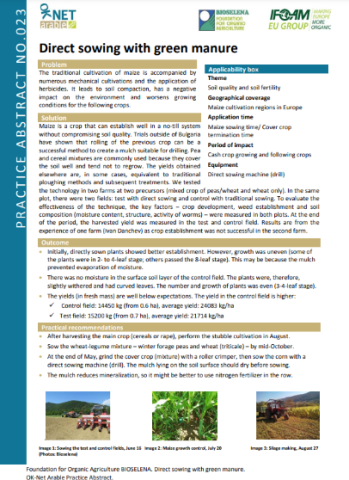Problem
The traditional cultivation of maize is accompanied by numerous mechanical cultivations and the application of herbicides. It leads to soil compaction, has a negative impact on the environment and worsens growing conditions for the following crops.
Solution
Maize is a crop that can establish well in a no‐till system without compromising soil quality. Trials outside of Bulgaria have shown that rolling of the previous crop can be a successful method to create a mulch suitable for drilling. Pea and cereal mixtures are commonly used because they cover the soil well and tend not to regrow. The yields obtained elsewhere are, in some cases, equivalent to traditional ploughing methods and subsequent treatments. We tested the technology in two farms at two precursors (mixed crop of peas/wheat and wheat only). In the same plot, there were two fields: test with direct sowing and control with traditional sowing. To evaluate the effectiveness of the technique, the key factors – crop development, weed establishment and soil composition (moisture content, structure, activity of worms) – were measured in both plots. At the end of the period, the harvested yield was measured in the test and control field. Results are from the experience of one farm (Ivan Danchev) as crop establishment was not successful in the second farm. Initially, directly sown plants showed better establishment. However, growth was uneven (some of the plants were in 2‐ to 4‐leaf stage; others passed the 8‐leaf stage). This may be because the mulch prevented evaporation of moisture. There was no moisture in the surface soil layer of the control field. The plants were, therefore, slightly withered and had curved leaves. The number and growth of plants was even (3‐4‐leaf stage). The yields (in fresh mass) are well below expectations. The yield in the control field is higher: Control field: 14450 kg (from 0.6 ha), average yield: 24083 kg/ha. Test field: 15200 kg (from 0.7 ha), average yield: 21714 kg/ha.
Description
Practical recommendations: After harvesting the main crop (cereals or rape), perform the stubble cultivation in August. Sow the wheat‐legume mixture – winter forage peas and wheat (triticale) – by mid‐October. At the end of May, grind the cover crop (mixture) with a roller crimper, then sow the corn with a direct sowing machine (drill). The mulch lying on the soil surface should dry before sowing. The mulch reduces mineralization, so it might be better to use nitrogen fertilizer in the row.
Download the practice abstract below.


